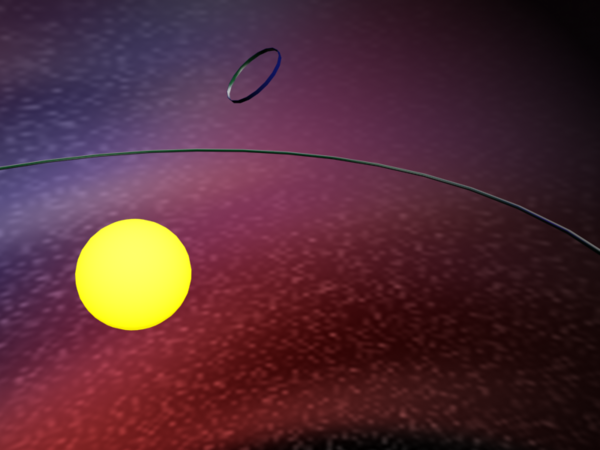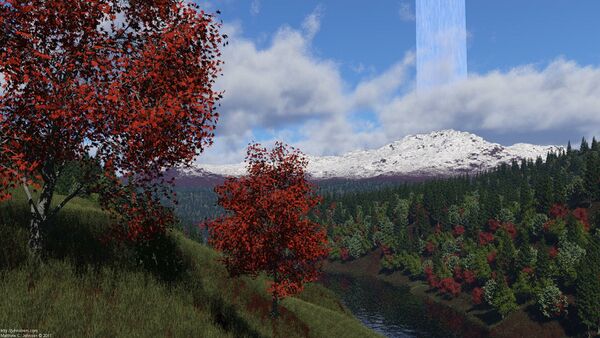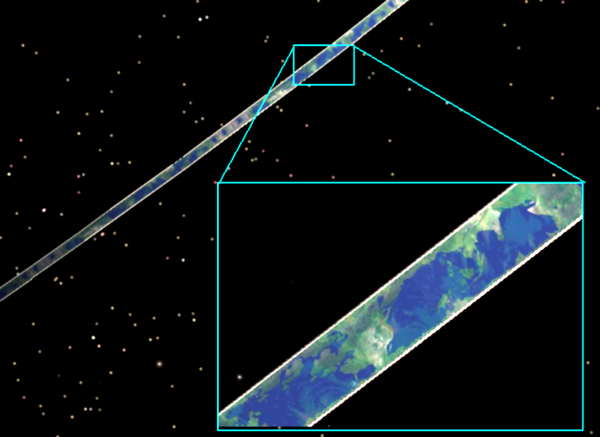Banks' Orbitals (A1-0)
This article needs to be updated. The reason given is: Categories are missing and the formatting is not up to the Wiki standard.. (May 2024) |

A Banks' Orbital is an extremely large ring-shaped artificial habitat that rotates to create artificial gravity along its inner surface. These large megastructures, anywhere from some tens of thousands of kilometers to one or two million in radius, can provide enormous habitable environments with surface areas that are hundreds to thousands of times that of a typical rocky planet. The enormous size of a Banks' Orbital and the stresses involved in its rotation mean that some form of exotic matter or advanced gravitometric technology is required for its construction and operation. A Banks' Orbital is not to be confused with a circumstellar megastructure such as a Ringworld: despite being essentially the same in their base design, ringworlds tend to be one or two orders of magnitude bigger than even the largest orbital.
Solids, liquids, and gases are held against the inner surface of the structure by the rotationally generated centrifugal force, and prevented from slipping off the edge into space by structural walls typically hundreds of kilometres high, often paired with nanorobotic airwall technology or energy fields. The megastructure orbits a star at the preferred distance for its constructors and inhabitants.
No form of ordinary matter will support the tensions generated by a spinning Orbital, so some kind exotic matter, advanced gravitometric technology or binding energy fields are required. Common examples for these include neutronium, magmatter, extended warp fields and others.
Banks' Orbitals are quite stable megastructures, with extremely low maintenance requirements. Unlike smaller orbital habitats they do not require imports of materials and careful management to maintain the stability of their internal ecosystem, and unlike more typical megastructures that use mass stream technology Orbitals that use exotic matter don't require constant attention to prevent physical collapse. Thanks to intensive and long simulation, it is estimated that a regular Banks Orbital might last for millions of years without maintenance before it became uninhabitable.
Design
Though the scale is orders of magnitude greater, the fundamental design of a Banks' Orbital is very similat to that of a Bishop Ring. It is a ring-shaped "open" habitat whose spin is strong enough to simulate gravity along its inner surface. Like a Bishop Ring, a Banks Orbital is open to space along its inner surface, so that inhabitants see a sky that is very similar to that seen from a regular planet's surface. The atmosphere is maintained on the interior surface of the Orbital and it is prevented from leaking away by high structural walls along the rim of the structure. Differently from a Bishop Ring however, the inner surface is illuminated directly by the star around which the Orbital revolves, rather than receiving light from artificial sources.
The radius of a Banks Orbital is directly proportional to the desired "gravity" on the inner surface and to the square of the desired day length. This means that each possible combination of day period and surface acceleration leads to a different size, with Orbitals envisioned with long days being relatively more expensive.
The structural rim walls of a Banks Orbital may be constructed in a variety of ways. Some are truly vertical walls, and in such cases, there may be many species and their associated ecosystems specially adapted to living on and in these high surfaces. In other cases the walls may rise more gradually, appearing to be very high mountains as seen from the interior regions of the inner Orbital. In other cases many different habitats may be constructed by creating a step-like series of mountains and plateaus, so that the middle layers have thin atmospheres and the upper layers are in vacuum or near-vacuum. This is often the case where a number of species and clades with radically different environmental requirements inhabit the same Orbital. The required height of these rim walls above the lowest surfaces of the Orbital is inversely proportional to the surface gravity and directly proportional to the desired atmospheric pressure on the surface. Rim walls can be constructed of self-supporting foamed diamondoid, or they can be created by varying the underlying weave of exotic matter and therefore allowing for the construction of walls of any height.
Typically speaking, Banks' Orbitals have very little width in proportion to their radius, typically at least a couple thousand of kilometers, but even this provides a very large surface area that is easily measurable in the hundreds or thousands of Earth-like surfaces.
Structure
The tension in the ring of a spinning Banks Orbital is tremendous, and as such no bonds between ordinary atoms are sufficiently strong to withstand it. Therefore, the foundation of any Orbital is exotic matter arranged in specialized configurations to create a vast weave upon which the other matter of the megastructure rests, gravitomagnetic technology capable of generating localized gravity fields to keep the structure in place, or various kinds of energy fields that achieve the same purpose. The outer face of the Banks' Orbital has additional layers of reinforced diamondoid and other materials, in part as an shielding layer in case of accidental impacts against the structure. However, most of the Banks' Orbital's mass is located inward from the core support layer. There is often a layer of diamondoid or other materials that forms the underlying contours of the terrain on the inner surface and helps provide additional rigidity. This is then followed by a layer of corundumoid and/or regular silicate rock hundreds or even thousands of meters thick that forms the Orbital's 'lithotorus' and serves the practical purpose of protecting the diamondoid from an oxygen-bearing atmosphere. Over these are liquids and gases forming the 'hydrotorus' and 'atmotorus'. A Banks' Orbital can support what inhabitants see as extreme differences in local topography, to provide a wide range of varying environments. Sometimes Orbitals may have walls or mountain ranges of the same height and similar structure as the rim walls, providing complete separation between compartments along the Orbital's circumference that may have radically different environments.
Though a Banks' Orbital may be constructed without them, it is not uncommon for one to be built with spoke-like structures used as anchors for transportation structures like Vacuum Trains, Shuttles and Maglev Pods to and from the rimwalls or for launching and landing stations for interplanetary or interstellar vehicles. They may also, in some implementations, be used as anchors for "roofs" or canopies that might be placed over portions of the Banks' Orbital habitat, where it is found useful to exclude radiation, or to maintain an higher air pressure than that allowed by the rim walls.
Maintenance
A Banks Orbital requires little maintenance compared to most other kinds of habitats and megastructures. Lighting, temperature and the atmosphere are all stable without interference, and the hosted ecosystem is large enough to cycle on its own without active management. The structure requires maintenance on a scale of centuries, millennia or more, and is not dependent on vast amounts of energy, materials and attention. Because their radius is much greater than their width, Orbitals are stable in their rotation, unlike tubular habitats such as McKendree and O'Neill Cylinders that require active or passive stabilization. Banks' Orbitals do not require active countermeasures against orbital precession, except on a scale of many thousands of years. Because of their size, Orbitals do not require shielding against cosmic radiation, and because gases and liquids are held against the inner surface entirely by its spin and rim walls, no active attention is required to retain them. The only true vulnerability of the megastructure is its core support system, although few natural forces are likely to disturb these, and those that could (such as rogue comets and asteroids or deliberate hostile attacks) are often prevented from causing damage and/or handled by defense and repair systems present on the structure.
The only thing that requires active, long term maintenance on an Orbital is the ordinary matter used to create the inner surface's topography and environment, since natural erosion is not counteracted by any other geological force. Over long periods of time, this would ultimately lead to the chemical alteration of the original minerals, the leveling of mountains, and the filling and increasing salinity of oceans and lakes.
Few Banks Orbitals are created to be entirely inert. Often, they have repair and self-maintenance systems comparable in complexity to those of a regular, albeit enormously huge, plant-like organism. This allows them to maintain their assigned orbital dynamics and physical homeostasis. In a few civilization, Orbitals may even be sentient by hosting large layers of computronium within their structures, in which case they handle their own defense and maintenance.

Habitable Surfaces
Topography & Environment
For many civilizations, the topography of a Banks Orbital is usually designed to maximize shoreline space. Maximizing transitional environments creates richer ecosystems, and placing land and water next to one another helps encourage daily and seasonal weather patterns that transport water inland and maintain the cyclical stability of the Orbital's hosted ecosystem. Large landmasses without lakes or seas may instead be created if dry land or desert environments are desired by the constructors. The terrain typically includes mountains and other variations in terrain, in part to make for a more varied and interesting environment, and in part to allow for different climates within the orbital. There would otherwise be little variation, since unlike a planet the strength of sunlight on an Orbital does not vary from one part of the structure to another.
As stated before, a Banks' Orbital allows for extremely high mountains, on the scale of the megastructure's rim structural walls. Like these, the mountains can be unique environments, ranging from gradual inclines to vertical cliffs of tremendous height. Such extreme topography can also be used to separate different regions within the Orbital, so that travel between sections is impossible without technological aid. This may be done to prevent the local wildlife from traveling and cross-contaminating two sections, or it may be to allow for radically different environmental conditions on opposite sides of the enormous mountain ranges.

Surface Illumination
From the surface of the megastructure, sunrise and sunset are more or less as they would be on a regular planet. Unlike on a planetary surface, it is possible to see dawn and dusk advancing towards one's location along the Orbital from a distance. The more distant portions of the ring form a great arch in the sky that narrows and darkens as it rises towards the zenith. If the megastructure's axis of rotation is tilted relative to the its plane of revolution about the local star, there is some variation in the intensity of light according to the time of year. If the orbital is given an eccentric elliptical orbit then there is also some variation in the apparent size of the star and the brightness of its light according to the time of year.
Nights on a Banks Orbital are very well lit by the light reflected by the more distant portion of the ring, covering half the sky in a great arch. The ring's night illumination is such due to its still illuminated half covering so much of the sky, and because the inner surface's clouds are generally more reflective than most moons. Wider rings therefore provide even more light in proportion.
Weather & Climate
Unlike on regular planets, Banks' Orbitals do not have great differences in insolation between pole and equator to drive their weather systems. In fact, they do not have any seasonal variation at all, other than that produced by an eccentric orbital motion or by a rotation that is tilted compared to the ecliptic. Those that do have a tilt have a pair of warm seasons and a pair of cool seasons once per orbit, that are not strongly marked without a notable inclination. The seasons are only half as long as they would be on a planet, and although the angle of the star changes, the length of the days always remains the same.
The Coriolis Effect does not have a significant effect on the weather of an Orbital. What Coriolis effect there is acts vertically rather than horizontally as on the surface of a regular planet. However, over the mere 10 kilometers high region of active weather, air currents and cloud shapes are hardly altered at all.
Without Coriolis effects and without major temperature gradients between different parts of the surface, there are few large scale weather systems of any kind. Cumulus clouds and thunderstorms, onshore and offshore winds and even some monsoon-like effects in titlted Orbitals are still present. Regardless, weather on a Banks Orbital is generally far gentler and more local than weather on a planet with the same conditions. Spoke structures equipped with systems to reduce the amount of sunlight received by particular areas can be used to generate stronger weather events, something that is common on Orbitals designed to produce a large number of radically different environments.
Transportation
The physical scale of a Banks' Orbital is such that the modes of transportation used on planets or smaller habitats are not sufficient to achieve travel between distant parts of the Orbital in reasonable timescales. Even the most rapid high speed vacuum maglev trains, with top cruising speeds of over 10,000 kilometers per hour, take weeks to fully circumnavigate the entirety of a medium-sized Banks' Orbital. Rapid travel between distant portions of the structure therefore requires the same dedicated spacecraft and shuttles that many civilizations also use for interplanetary travel. Another alternative used by some is advanced teleportation or matter reassembly, that can immediately transfer people and objects from one side of the vast ring to the other.
Banks Orbitals in Sector A1-0
Sources:
- Orion's Arm: https://www.orionsarm.com/eg-article/4845ef5c4ca7c
- Isaac Arthur: https://youtu.be/3nxBPHZ2xJM?si=EBY-wVjHYqNnyT7T